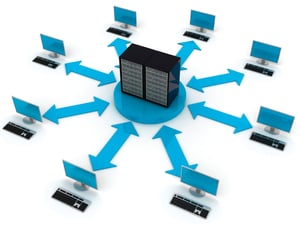 The Software Defined Data Center is a buzzword that is drawing the attention of IT writers, strategists and leaders across the world. The reality is clear, the traditional data center is nearing its end-of-life and in its place will be a new data center that is software driven. It will liberate not just the data, but the processes and services of the organization as well. It’s an idea that has a lot of IT leaders thoroughly excited.
The Software Defined Data Center is a buzzword that is drawing the attention of IT writers, strategists and leaders across the world. The reality is clear, the traditional data center is nearing its end-of-life and in its place will be a new data center that is software driven. It will liberate not just the data, but the processes and services of the organization as well. It’s an idea that has a lot of IT leaders thoroughly excited.
“Just as the world changed when isolated networks became the Internet, computing is about to make a quantum leap to “data centers” abstracted from hardware that may reside in multiple physical locations. This pervasive abstraction will enable us to connect, aggregate, and configure computing resources in unprecedented ways.”
-Eric Knorr, Editor in Chief of Infoworld
“The software-defined data center (SDDC) is crucial to the long-term evolution of an agile digital business.”
-Gartner
“The enterprise must become an operating system so that your employees can innovate on top of what is essentially your company.”
-Paul Muller, VP of Strategic Marketing for HP
We often talk about disruptors today such as Uber, Pandora and AirBnB and the transforming revolutionary change they can bring about within an established industry seemingly overnight. The fact is that the data center was disrupted just over a decade ago when VMware unleashed server virtualization into the data center environment. This new technology challenged IT Managers with an entirely new approach to server provisioning and distribution but with these challenges came unprecedented opportunity. SDDC also exposed the great bottleneck that the other components of the data center inherently produce which is now the next fundamental challenge.
THE CHALLENGE AND OPPORTUNITY OF TRANSITIONING YOUR DATA CENTER
For those organizations who currently utilize a virtual server farm, you probably didn’t virtualize your server infrastructure overnight. Chances are you started with a two or three node cluster and virtualized a handful of new servers.
Next you probably migrated a few existing servers to the virtual environment. As you became more comfortable and confident with the new technology you then expanded your host infrastructure as your budget allowed, continuing the process of virtualizing new servers and migrating physical servers as they reached end-of-life. Due to the flexibility that is characteristic of software defined computing (SDC), you were able to complete the entire project with very little interruption to the network and are most likely absolutely sold on the advantage of SDC, long forgetting the initial challenges at the outset.
The process of transitioning your data center to a software ecosystem is no different. IT managers can implement virtual storage appliances or VSANs in a regimented fashion to transform their storage infrastructure into a software driven commodity software ecosystem in the same manner they did their virtual storage farm. In addition, many leading enterprise vendors such as HP, VMware and Cisco are releasing SDN enabled equipment that can work in both traditional and software defined environments. They key is to plan for your SDDC today, freeing you from both vendor lock-in and expensive proprietary hardware.
REDEFINING AND DELEGATING THE IT STAFF OF TOMORROW
Like any new technology, IT managers must be concerned about finding talented professionals with the required knowledge base as well as training current staff employees. For SDDC environments however, it involves a more fundamental examination into the delegation of IT responsibilities. Who will manage your switches, routers and storage silos in a data center in which everything can be managed from a single pane of glass? Will it be the network admin? The virtualization admin? Will everyone have rights to the hypervisor? An important prerequisite for a successful SDDC implementation will require management to redesign its IT staff into one that is centered around innovation and management rather than updating and troubleshooting hardware. The SDDC staff will feel more empowered and impactful within their organization.
STORAGE AND LOCATION INDEPENDENCE
When we virtualize a server, it essentially becomes a file, and a file can be stored anywhere. Yet how many data centers have these files residing on expensive dedicated SANs that are centrally congregated at one location? In SDN environments, physical plane devices will be managed by software policies, which can be stored and delivered anywhere. Mobile computing is challenging enterprises to be fluid in their design and operation and SDDC can accomplish this.
SECURITY AT THE SPEED OF AUTOMATION
We cannot have a realistic discussion about SDDC without a thorough deliberation on how we are going to secure it. The fragile nature and vulnerability of today’s data center was clearly exposed in the ransomware attack on the Hollywood Presbyterian Medical Center in February of 2016. Despite having the traditional walled city fortress that protected the internal LAN, the network was brought down by the simple click of a mouse by an unsuspecting user which immediately downloaded a malware application. Within minutes, a large share of the hospital’s data was encrypted, forcing the IT staff to shut down the system. Eventually the hospital administration gave in and paid the ransom to the attackers in order to receive the key to unlock the encryption.
Just like tactics of warfare must constantly modulate and change in order to counter new technologies and tactics, today’s IT leaders must modernize and transform their own security tactics to protect the data center. During the early feudal period in Europe, cities protected themselves with a combination of walls and moats which served them well, until armies became more mobile and obtained new technologies which nullified this defensive approach. In World War 1, the concept of trench warfare was nullified by the implementation of air warfare. Similarly, the concept of the walled perimeter protecting the LAN has reached its end-of-life as computing has become mobile, fluid and app driven.
The wall and moat mentality of IT security is centered around combating infiltration. But in today’s elastic computing environment, we need a new approach to security that is geography independent. It needs to run in automated fashion, managed by a centralized intelligent controller that can analyze the network for threats at both a macro and granular level big picture. The unprecedented accelerating rate of technological change and innovation will bring with it an infinite variety of circumstances and these must be countered by a security methodology that can adapt at this rate of change. Only by abstracting the security intelligence from the hardware layer can these objectives be accomplished.
SUMMARY
Today’s enterprises are under the threat of being overwhelmed by constantly evolving security threats, an expanding and accelerating mobile world and a business environment that demands constant innovation. All of these challenges can be met with the constant theme of flexibility and elasticity, the very characteristics of SDDC that make it such a powerful solution for the data center of today, and tomorrow.
About WEI
WEI is an innovative, full service, customer-centric IT solutions provider.
Why WEI? We go further.
At WEI, we’re passionate about solving your technology problems and helping you drive your desired business outcomes. We believe in challenging the status quo and thinking differently. There are a lot of companies that can take today’s technology and create a great IT solution for you. But we do more. We go further. And we have the customer, vendor and industry awards to prove it. WEI is a premier technology partner, who always puts our customers first while providing the most innovative solutions for over 30 years.


